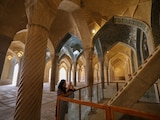- Durgiana Mandir in Amritsar resembles the Golden Temple in architecture and setting
- It features silver-plated doors and a sarovar with marble sculptures and shrines
- The complex includes shrines to Hanuman, Shiva, and a unique Ramayana manuscript
A visit to Amritsar usually follows a familiar script: praying at the Golden Temple, indulging in buttery Amritsari kulchas, bargaining for embroidered juttis and sipping kulhad chai late into the night at the Heritage Walk. But on my most recent trip, something unexpected caught my attention. After paying my respects at Sri Harmandir Sahib, I discovered another golden shrine glimmering quietly within the city - a temple so similar in appearance that, at first glance, it felt like a mirage. This serene counterpart is the Durgiana Mandir.
A Temple That Mirrors The Iconic Harmandir Sahib
The Durgiana Temple takes its name from Goddess Durga, and within its sanctum, idols of Goddess Lakshmi and Lord Vishnu are also enshrined. Architecturally, however, it bears an unmistakable resemblance to the Golden Temple. Rising from the middle of a sacred sarovar, the structure features a central dome, canopies and the harmonious symmetry seen in Sikh architecture.
The temple's calm ambience mirrors that of the Golden Temple - peaceful walkways, shimmering reflections on the water and a sense of spiritual stillness that quietly envelopes you.
A Brief History of Durgiana Mandir
Although the site existed earlier, the present-day temple was rebuilt in 1921. Its foundation stone was laid in 1924 by Pandit Madan Mohan Malviya on Ganga Dashami (Dussehra). According to local accounts, during the Partition, the shrine offered refuge to displaced families, becoming a sanctuary at a time of immense upheaval.
Architecture Of Durgiana Temple
Designed in a style reminiscent of Sikh architecture, the Durgiana Temple features domes, canopies and intricately worked facades. The main dome and upper walls are carved with gold. The temple is also called the 'Silver Temple' due to its striking silver-plated doors, adorned with carvings of Goddess Durga and Lord Ganesha on the main gate, and other deities on the side gates.
Like the Golden Temple, the shrine sits in the middle of a sarovar (religious pool of water) and can be reached via a white-marble bridge, creating a sense of arrival that feels both familiar and distinct. The resemblance between the two temples is a testament to the enduring cultural and architectural heritage that defines Amritsar and the Punjab region.
A Sprawling Complex Of Shrines And Sculptures
The temple complex is vast and dotted with marble sculptures. Statues of deities line the edges of the sarovar, where devotees can also spot colourful fish gliding through the water. Lord Shiva is depicted in a meditative pose on a platform within the pond.
An unusual sculpture of a seated Hanuman catches the eye, adding to the curiosity the complex evokes. Several smaller shrines encircle the main temple, including the Bara Hanuman Mandir, Mata Sitla Mandir and temples dedicated to Sat Narain and Radha Krishna.
Nearby, the Goswami Tulsidas Mandir houses a unique handwritten copy of the Ramayana, a treasured draw for those interested in literary and spiritual history.
A Haven Of Peace
Away from Amritsar's bustle and crowds of devotees, the Durgiana Mandir offers a refreshing sense of serenity. The gentle hum of prayers, the reflection of gilded domes in the water and the soothing atmosphere create a space that encourages visitors to pause, breathe and reconnect.
Best Time To Visit The Durgiana Mandir
The most comfortable months to explore the Durgiana Mandir are from October to February, when Amritsar's weather turns pleasant. Summers (March to June) can be extremely hot, and monsoons often make walking around the city cumbersome. However, the temple welcomes devotees and visitors throughout the year.
How To Reach The Durgiana Temple
Located in Goal Bagh near Hathi Gate, the shrine is easily accessible from anywhere in the city. Once in Amritsar, a short tuk-tuk or cab ride will take you straight to the complex.
Entry Fee And Timings
There is no entry fee for visiting the temple.
Timings:
- 6:00 am - 12:00 pm
- 12:30 pm - 10:00 pm
The next time you visit Amritsar, pay a visit not only to the iconic Golden Temple, but also to the lesser-known Silver Temple.






